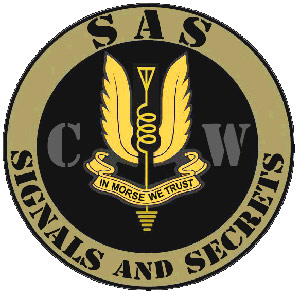|
Thursday 7.0257 MHz ± 2 kHz 2140 NZT (0840Z summer 0940Z winter). If conditions are too poor on 40 m the net will QSY to 3.5257 MHz ± 2 kHz
Not the LATEST NEWS now, but still the best VK3BTV and ZL3TK achieved the first known amateur trans-Tasman exchange of Enigma-encrypted traffic in June 2024 using virtual M3 machines, the same machines as those deployed by the German Heer and Luftwaffe (army and air force). This exchange took place three years after the first intra-ZL exchange of Enigma traffic between ZL1ANY and ZL3TK, and nine years after the idea was first imagined. Click here to view the Enigmagrams
The SAS Net is all about business, whether that be training for traffic handling or traffic handling itself, it will be devoid of idle chatter. The underlying purpose is to efficiently pass traffic, preferably encrypted traffic, with the dual goals of education and CW skill-building. There is one codicil: in all cases where encrypted traffic is sent, it must include an OPNOTE pointing to an ad hoc decrypt utility. Imagine yourself as a British SOE-trained radio operator who has been dropped into Nazi occupied Europe to support an established SOE agent or to join one of many escape lines, resistance groups such as the Maquis in France, or Italian partisans. Your contacts will be with only your SOE handler's radio operator in London, conducted in in Morse code at scheduled times on crystal-controlled frequencies, your information and questions often going unacknowledged. Because of the short life expectancy of clandestine radio operators in war time, your equipment will always be carefully hidden until it is needed, then transmissions must be as brief as possible to avoid detection by the Wehrmacht RDF, Funkpeilung. The limits of that SOE concept do not confine the SAS CW Net, on the contrary, any secret communications used by any nationality may be used, the Stazi, the Kempeitai, KGB, CIA, etc., the One Time Pad and Enigma being the most common for CW exchanges. In-clear QTCs are also acceptable for training in traffic protocols or passing general information. These are considered exercises leading to encrypted traffic handling.
Listeners are invited to join in by copying
encrypted traffic regardless
Here's an opportunity to
put your CW skills
to serious use
through innovation, challenges, encryption and plain-text QTCs.
Between weekly nets, calling frequencies are 3.5157 MHz and 7.0257 MHz,
https://cryptii.com/
is a resource providing many encryption options,
not all are suitable for CW.
Cryptii runs on your browser Java platform and does
not need installation ... try it, it's clever,
Experimentation with diverse
encryption methods is welcome, so long as a |
||||||||||||||||
|
Contributors to this net are invited
to submit
their Wireless Telegram
|
||||||||||||||||
Some Considerations Regarding Encrypted CW Traffic.
German Enigma traffic was sent only once. No repeats or
repeat requests were permitted due to a known
lack of operator discipline which could compromise the security of the key
and therefore the message contents. Nonetheless, Enigma worked successfully
because random letter-for-letter substitution meant that a single
letter error resulted in only a single-letter error in
decryption. Despite the occasional error, the context was usually sufficient
to provide an acceptable understanding of the message text, bearing
in mind digits were not included on Enigma keyboards. This
meant that all
numbers had to be spelled out which eliminated any ambiguity issues with
map coordinates, orders, weather reports or military results. Repeats are a necessity for dictionary-based encryption systems. Repeats are not a threat to the key, and indeed contemporary OTP traffic is repeated over and over by those mysterious ‘number’ stations. One-for-one random letter substitution is used and integers may be included, so there's no need for numbers to be spelled out so long as the dictionary includes them.
On the SAS Net when passing encrypted traffic,
we send the message text twice to reduce error counts. A procedure alert . ??
is sent at the end of the first instance, then the message
text is repeated, the second instance ending with the standard
= <BT> Longer transmissions are not such an important factor in 21st Century amateur radio environment, considering ... 1. You're not bobbing about in the Atlantic in a surfaced Unterseeboot ... and 2. there are no keen WRNS Wrens in wooden huts at intercept stations all along Great Britain's south coast eagerly trying to DF you! We can afford to be quite relaxed time-wise allowing as many repeat requests as needed to complete the task.
How to configure M3 and M4 Enigmagrams
|
||||||||||||||||
Return to website index
|
||||||||||||||||



